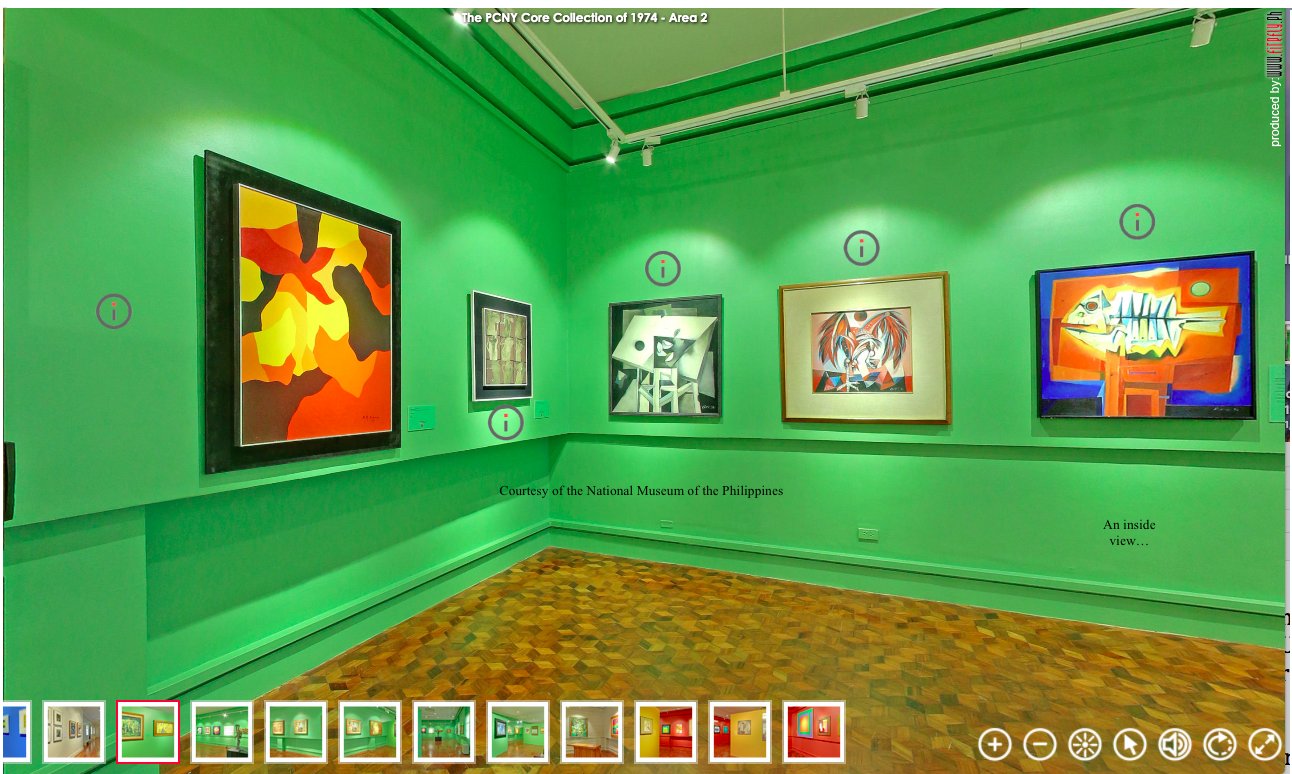If I can make it there
I can make it anywhere!
Liza Minelli, New York, New York
The Philippine Center New York Core Collection of 1974 is back home in Manila after 47 years, with all 115 out of 120 art works by 52 Philippine artists for the inauguration of the Philippine Center, New York City.
The Homecoming Exhibition of the Philippine Center New York Core Collection of 1974 can be seen at the National Museum of the Philippines website through a 360-degree virtual tour captured and rendered by Fung Yu, a panorama photographer (http://pamana.ph/ncr/manila/pcny360.html). It can also be viewed in Galleries 27 and 28 of the museum until February 13, 2022. An appointment is required. Since 02 March 2021, the National Museum has reopened its doors to the public.
Nine of the artists in the collection were later conferred the Order of National Artists, namely: Federico Aguilar Alcuaz, Ang Kiukok, Benedicto Cabrera, Jose Joya, Cesar Legazpi, Arturo Luz, Vicente Manansala, Jerry Elizalde Navarro, and Hernando Ocampo.
Belleza and Hwang
Of the 52 artists, only two are women: Norma Belleza (1939) and Lillian Hwang. Belleza is known for her genre paintings of ordinary people such as women vendors and potters in her folk characteristic style of intense colors and stocky figures, as seen in her Basket Weaver (1974).
Lillian Hwang has two paintings entitled Green, Yellow, Red, Purple (1973) and Shocking Pink, Orange, Maroon (1974). She describes her works as “calligrams” or geometric patterns painted in bright colors.
Stories in figurative and abstract
Presenting the Philippines through the eyes of its visual artists, the Philippine Center New York Core Collection of 1974 represents a variety of figurative and abstract art works, amidst the turbulent realities of the country in the 1970s.
The exhibit opens with the works of Vicente S. Manansala (1910-1981), the artist at the forefront of the modernist movement in the 1950s. His Kalabaw (1965), a watercolor done in translucent shades of geometric greens and yellows, encapsulates the rural landscape in its different permutations. While it is the only Manansala work in this collection, it is a tribute to the modernist force that the artist had unleashed in influencing two generation of artists that include Jose Joya, Ang Kiukok, Mauro Malang Santos, Mario Parial, Angelito Antonio, Manuel Baldemor, and many more.
Figurative works depict ordinary Filipinos in their everyday life and labor as seen in in Angelito Antonio’s (b. 1939) Planchadora and Magmamais, both done in 1974.
A people’s religiosity is reflected in images of churches, saints, the Sto. Niño, and the Crucifixion, as well as religious festivals and processions.
The rural landscape, expressive in many styles, is represented in nipa huts, carabao on pasture, seashore and woods, a fisherman’s village, birds and fish. Kalikasan (A/P, 1973), a black-and-white woodcut print by Mario Parial (1944-2013), captures the dense and variegated foliage running wild in the countryside.
In the realm of prints, several etchings are on display by Manuel Rodriquez, Sr. (1913-2017), the father of Philippine printmaking. It includes Festival of Boats, Moriones, and Serenade, all 1974 works.
Jerry Elizalde Navarro’s (1924-1999) Night Landscape (1974), with its joyful outburst of colors, foreshadows other works of abstraction in the exhibit. Vivid color and rhythm predominate amidst highly stylized expressions in Jose Joya’s Blue Apostrophe (1973), as well as a series of serigraphs by Rodolfo Samonte.
The 1970s abstractionists (Rodolfo Samonte, Raul Isidro, Lao Lianben, Raul Lebajo, Lamberto Hechanova) all experimented with oil, acrylic, and automotive paint to create lines, planes, and colors that elicit pure visual pleasure on a flat surface. In many ways, abstract compositions seek to distill the mind’s inner workings and offer a space for reflection in an uncertain and chaotic world.
Likewise, a number of sculptures are shown, among them Aquarius (1974) by Solomon Saprid (1917-2003) who is known for his Tikbalang series; Grid I (1974) and Shaft (1974) in wood by Arturo R. Luz (b. 1926); and Eduardo Castrillo’s (1942-2016) work in brass, Assembled (1974).
Background
Two years into martial law, the Philippine Center New York was inaugurated in November 1974 where its art collection has been displayed ever since. It was Arturo Luz who was then the director of the Metropolitan Museum of Manila, the Design Center of the Philippines, and the Museum of Philippine Arts, together with well-known designer Wili Fernandez who gathered and purchased a total of 120 artworks by 52 Filipino artists.
Initially selected “to represent Philippine national identity in the context of the prevalent style of the international art scene in the 1970s,” its homecoming is appreciated today, in a much different time.
It remains a landmark collection in the development of Philippine modern art, representing the best expressions of modernity by a select group of Filipino artists.






